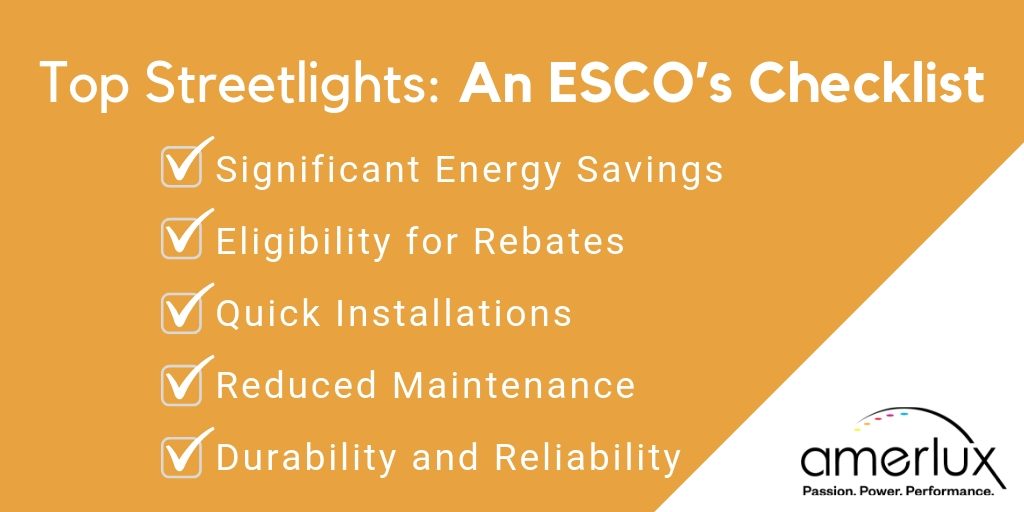Top Streetlights: An ESCO’s Checklist

Energy service companies (ESCOs) continue to save companies large sums of money by offering a broad range of energy solutions that have tapped into the rapid proliferation of LED lighting during the past five years.
According to an Advanced Energy Economy’s study, “U.S. building efficiency products and services grew by 8 percent, or $5 billion in 2016, led by energy-efficient lighting and commercial building retrofits, both up 7 percent, reaching $26.4 billion and $8.4 billion respectively.”
As noted in a 2015 Electrical Contractor article by author Timothy Johnson, a recent study by energy efficiency and financing firm Noesis confirmed that lighting is the most popular energy-efficient upgrade undertaken in the U.S., proposed four times as much as HVAC upgrades, which ranked second.
Among lighting activity, LED upgrades in particular are expected to have the greatest potential impact on energy savings in the U.S. The widespread use of LEDs during the next decade could save nearly 350 TWh of electricity—the equivalent annual electrical output of 44 large electric power plants or the annual energy consumed by the entire state of Texas—and deliver total energy cost savings of more than $30 billion at current electricity prices, according to the U.S. Department of Energy.
Among the LED lighting upgrades being conducted, streetlighting upgrades within the estimated 25-44 million streetlights resident in cities, towns, and municipalities nationwide are one of the fastest-growing segments of the LED market for many reasons.
A Checklist for LED Streetlighting Upgrades
Industry studies confirm that the market for LED streetlighting upgrades is robust with an estimated 600+ cities from New York to Los Angeles and everywhere in between currently reporting that they’ve either upgraded or are in the process of upgrading their streetlights to LEDs thanks to the many benefits LED technology delivers to streetlighting applications.

Here are several factors that ESCOs consider when retrofitting pedestrian lighting for cities:
- Significant Energy Savings: The majority of today’s streetlights feature outdated technology, which include high-pressure sodium, metal halide, mercury vapor and fluorescent sources. In contrast, LED technology can slash energy consumption and costs by 40 percent or more, reducing a city’s operating costs and the subsequent burden on local taxpayers.
- Eligibility for Rebates: According to experts from New Jersey-based rebate specialist firm BriteSwitch, nearly 80 percent of the U.S. is covered by an active commercial lighting rebate program as of 2017 and the majority of these programs feature incentives on LEDs (often vetted by the DesignLightsConsortium (DLC), an organization which establishes product quality specifications in an effort to promote high-quality, energy-efficient lighting products). These attractive rebates can offset lighting projects costs by as much as 25 percent, reducing project payback periods, while increasing their ROIs. LEDs are also popularly supported through utility performance contracts, which studies confirm are the operational model through which more than half of the ESCO community’s current projects are conducted.
- Quick Installations: Most Avista retrofit installations take less than 15 minutes per fixture.
- Reduced Maintenance: Thanks to their longer lifespan relative to older technologies, 50,000-100,000-hour LEDs can deliver years of maintenance-free operation, allowing cities to realize significant reductions in maintenance costs. According to the U.S. DOE, maintenance savings from the installation of LED lighting equates to roughly $50 annually per fixture and can deliver users up to twice the financial advantages available through energy savings during the fixtures’ lifetime.
- Durability and Reliability: While conventional light sources may not always be able to withstand certain types of harsh environments and extreme weather conditions, the unique properties of LEDs render them extremely durable and weather-resistant, especially in cold and/or wet conditions. Additionally, thanks to their durable components, LED streetlights are less vulnerable to vandalism than other light sources.
Still Want More?
- Bright Lights, Beautiful City: How Portland Cut its Energy Bill by 60 percent
- Recasting Showbiz City in Best Light: How Downtown L.A. Reduces Energy Bill by 75 percent
- Top Pedestrian Lights: Why ESCOs Choose Amerlux

